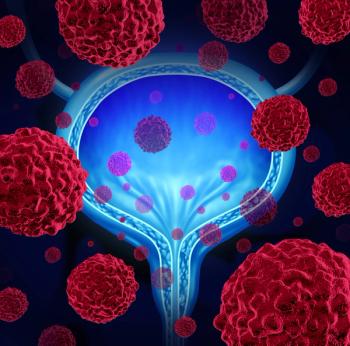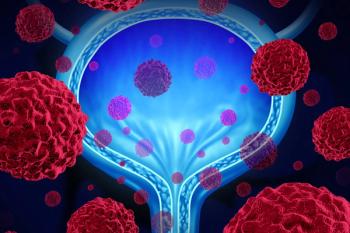
Evaluating Two RT-Plus-Chemotherapy Strategies in Bladder Cancer Patients Undergoing Bladder Surgery
In this interview, we spoke with John J. Coen, MD, a radiation oncologist who presented results at the 2018 Genitourinary Cancers Symposium of a phase II study exploring two different radiation-plus-chemotherapy combination strategies in patients undergoing bladder surgery for their tumors.
As part of our coverage of the 2018 Genitourinary Cancers Symposium in San Francisco, California, we spoke with John J. Coen, MD, a radiation oncologist at 21st Century Oncology in Providence, Rhode Island, where he specializes in the care of patients with bladder and prostate cancer. At the meeting, Dr. Coen presented results of the Radiation Therapy Oncology Group (RTOG) 0712 trial, a phase II study exploring two different radiation-plus-chemotherapy combination strategies in patients undergoing bladder surgery for their tumors.
-Interviewed by Anna Azvolinsky
Cancer Network: Can you tell us briefly about the major question this trial was addressing, and the study design?
Dr. Coen: Certainly. The RTOG has studied selective bladder preservation in patients who are candidates for cystectomy. These are patients who are healthy enough to have their bladders removed but are choosing a bladder-sparing option-as opposed to certain patients who are not even candidates for this surgery. This treatment paradigm has been pioneered and refined through the RTOG over a number of years. It involves a maximal transurethral resection of bladder tumor [TURBT] followed by induction radiation plus chemotherapy. Then there is a mid-treatment assessment, where patients who have a complete response go on to receive consolidation chemoradiation but those who have less than a complete response are referred for a radical cystectomy. There have been a number of trials refining that paradigm and RTOG 0712 was the most recent version.
So this trial randomized patients to two regimens, one of which-5-FU cisplatin plus twice-daily radiation therapy-was the RTOG standard at the time. The other regimen was low-dose gemcitabine plus once-daily radiation therapy, a treatment developed at the University of Michigan that had been shown to be effective. RTOG 0712 evaluated the efficacy of both regimens, with the primary endpoint being distant metastases at 3 years. If either study arm exceeded a benchmark rate of 75% freedom from distant metastases, then the regimen used was considered strong enough to be looked at in future trials. So, it was like a preliminary phase II trial to potentially prepare for a phase III trial. That was the thinking behind this study.
Cancer Network: What were the major results of the study?
Dr. Coen: A total of 70 patients were accrued to RTOG 0712. The first report on the study was available in 2017, and it demonstrated high rates of freedom from distant metastases at 3 years in both arms. The rate was 78% in the group treated with the prior RTOG standard of 5-FU cisplatin plus twice-daily radiation therapy, and it was 84% in patients randomized to gemcitabine plus once-daily radiation therapy. The trial really was not designed to compare treatment arms, but it did show that both regimens were reasonable and had high rates of efficacy, so they could be carried forward. Both regimens were quite well tolerated. There were very low rates of genitourinary and gastrointestinal events during treatment.
Both groups showed high rates of complete response. The complete response rate was 88% in the patients who received twice-daily radiation plus 5-FU cisplatin, and was 76% in those treated with once-daily radiation plus gemcitabine, so that was also a favorable outcome. Bladder-intact distant-metastases-free survival was a secondary endpoint in this trial. This is a composite endpoint that evaluates whether patients are free of distant metastases and whether we successfully spared their bladders. Scorable events for this composite endpoint would include distant metastases, death due to any cause, or cystectomy. At 3 years, the rate of freedom from failure of this endpoint was 67% for patients randomized to twice-daily RT plus 5-FU cisplatin and was 69% for those randomized to once-daily RT plus low-dose gemcitabine. These results tell us that the rates of freedom from distant metastases were high in both arms, were similar, and exceeded the study’s designated benchmark rate of 75%. So, both arms could reasonably be carried forward into successor trials. Treatment was well tolerated in both study arms.
The rates of complete response were quite high in both arms and exceeded the historical rates by a fair margin. However, the results are not necessarily a reflection of these two regimens being more efficacious; as time went on with this series of RTOG studies, patient selection became more refined. For example, hydronephrosis is excluded in more contemporary trials whereas it was not necessarily an exclusion factor in the initial trials. Also, more thorough TURBTs or transurethral resections were performed as time went on, which certainly increased complete response rates. Bladder preservation rates were high and fairly similar between study arms as well.
So, there are a few things that we can take forward from this study. First, concurrent low-dose gemcitabine is a reasonable alternative to cisplatin in a broader bladder-preservation regimen. This is important because many patients with bladder cancer may be older and living with comorbidities. Patients with poor renal function or hearing deficits are not good candidates for treatment with cisplatin, which was a component of most bladder-preservation regimens in the past. So having an effective regimen that omits cisplatin is an important thing. This trial also showed that daily radiation is a reasonable alternative to twice-daily radiation, and that certainly allows for wider adoption of selective bladder preservation using trimodality therapy.
Cancer Network: What is next for these two different chemoradiation regimens? Should they be tested in a larger trial, and is such a trial now being planned or already underway?
Dr. Coen: There is a successor trial being planned in combination with the NRG and also the Southwest Oncology Group. This will be a bladder-preservation trial, and several concepts will be carried forward from RTOG 0712. The trial will incorporate once-daily radiation and there will be no treatment break, so patients will go on to receive the full dose and not have a mid-treatment assessment of the effect after they have completed therapy. The trial will allow several different chemotherapy regimens, including low-dose gemcitabine, a cisplatin regimen, and at least one other regimen.
Cancer Network: What are the options currently for patients enrolled on this trial who have muscle-invasive bladder cancer that has spread into surrounding tissues but not metastasized? Also, what other therapy options are being explored for these patients?
Dr. Coen: Currently in the US, an option for treatment of muscle-invasive bladder cancer could be TURBT alone; it has been considered for patients with fairly minimal disease. While TURBT is usually offered predominantly to older patients because its efficacy is somewhat limited, there is a subset of patients for whom it might be reasonable. Secondly, radical cystectomy is certainly the most common form of therapy for patients with muscle-invasive bladder cancer. Bladder-sparing trimodality therapy, which incorporates a maximal transurethral resection followed by chemoradiation, would be the third option. The trial that I just discussed will evaluate a selective bladder-preservation regimen, and a key component is that there is close urologic surveillance and a prompt cystectomy will be offered if there is any sign that treatment is not going in the right direction. For patients who are poor surgical candidates, definitive chemoradiation therapy is also an option.
Newsletter
Stay up to date on recent advances in the multidisciplinary approach to cancer.
















































































